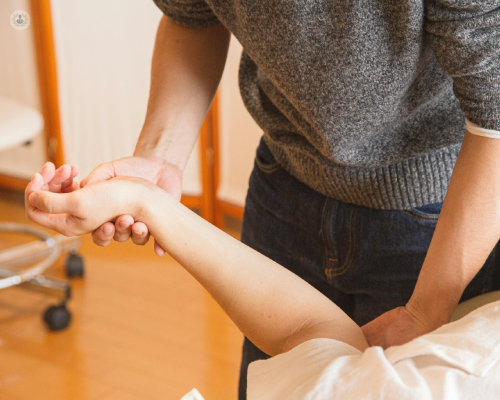Beyond the cast: advanced non-surgical treatments for upper limb injuries
Escrito por:Upper limb injuries are a common concern due to their potential to limit mobility and disrupt daily activities. These injuries, affecting the shoulder, elbow, wrist, and hand, can range from mild sprains to more serious tendon and ligament damage, often requiring swift management to prevent long-term complications.
Mr Nashat Siddiqui, an experienced orthopaedic surgeon, explores the importance of early diagnosis and the latest non-surgical treatments available for upper limb injuries. He highlights innovative therapies, rehabilitation strategies, and the role of advanced technologies in promoting recovery and restoring function without the need for surgery.

What are the most common upper limb injuries?
Upper limb injuries can occur in various parts of the arm and shoulder.
Common conditions include:
- Tennis elbow (lateral epicondylitis): an overuse injury affecting the tendons of the elbow.
- Rotator cuff injuries: damage to the muscles and tendons that stabilize the shoulder joint.
- Carpal tunnel syndrome: compression of the median nerve in the wrist, leading to numbness and tingling in the hand.
- Fractures: broken bones in the hand, wrist, or forearm.
- Bursitis: inflammation of the fluid-filled sacs (bursae) that cushion the joints, especially around the shoulder or elbow.
What are the benefits of non-surgical treatment?
Non-surgical treatments offer several advantages over surgery, including:
- Faster recovery time: many non-surgical methods allow patients to resume normal activities more quickly.
- Reduced risk: avoiding surgery reduces the risk of complications such as infection, scarring, or blood clots.
- Less invasive: non-surgical options are typically less painful and do not require anaesthesia or hospitalization.
What are the most common non-surgical treatments?
- Physiotherapy
Physiotherapy is often the first line of treatment for upper limb injuries. Specialized exercises aim to restore mobility, strengthen muscles, and reduce pain. A physiotherapist may use manual therapy, stretching, and strength training to improve the function of the affected area. For chronic injuries, long-term physiotherapy may prevent recurrence.
- Corticosteroid injections
Corticosteroid injections are used to reduce inflammation and pain, particularly for conditions like tennis elbow, bursitis, and rotator cuff tendinitis. The relief can be almost immediate but is usually temporary, making it ideal for managing acute symptoms while continuing other treatments like physiotherapy.
- Platelet-Rich Plasma (PRP) therapy
PRP therapy involves injecting a concentrated dose of the patient’s own platelets into the injured area to promote healing. This technique is gaining popularity for treating tendon and ligament injuries, such as rotator cuff tears or tennis elbow. PRP is considered a newer, regenerative treatment that may speed up recovery, although it is still considered experimental by some experts.
- Extracorporeal shockwave therapy (ESWT)
Shockwave therapy uses sound waves to stimulate healing in injured tissue. It is commonly used for chronic tendinitis, including in the elbow or shoulder. The treatment promotes blood flow and encourages the body to repair damaged tissues more efficiently. ESWT is non-invasive and can be an option for patients who do not respond well to physiotherapy or injections.
- Ultrasound-guided hydrodilatation
For patients with frozen shoulder or severe bursitis, hydrodilatation can provide relief. This procedure involves injecting a saline solution into the joint capsule under ultrasound guidance, which helps to stretch the tight joint and reduce pain. It’s a newer treatment that shows promise for restoring shoulder mobility without the need for surgery.
- Splints and braces
For certain conditions, such as carpal tunnel syndrome or wrist fractures, wearing a splint or brace can immobilise the affected area and promote healing. These devices help to reduce strain on injured tendons and ligaments, providing the necessary support for recovery while maintaining some functionality.
- Nerve block injections
In cases of severe pain, especially from nerve-related conditions like carpal tunnel syndrome or complex regional pain syndrome, nerve blocks can offer relief. These injections target specific nerves to temporarily "block" pain signals. Though not a permanent solution, nerve blocks can provide significant pain relief while other treatments, like physiotherapy, take effect.
Are there any risks with non-surgical treatments?
Non-surgical treatments are generally safe but are not without potential risks. Some patients may experience temporary discomfort or minor side effects, such as swelling or bruising from injections. Additionally, newer treatments like PRP therapy or shockwave therapy may not be covered by all health plans, and their effectiveness can vary between individuals.
When should surgery be considered?
While non-surgical treatments are highly effective for many upper limb injuries, surgery may be required if:
- The injury is severe, such as a complete tendon rupture or complex fracture.
- Symptoms do not improve after several months of conservative treatment.
- There is a loss of function that significantly impacts daily activities.
In such cases, a consultation with an orthopaedic surgeon will help determine whether surgery is necessary.
If you’d like to learn more about advanced non-surgical treatments for upper limb injuries, schedule a consultation with Mr Nashat Siddiqui via their Top Doctors profile.


